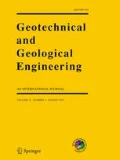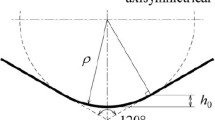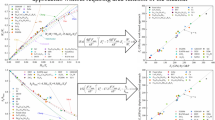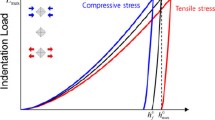Abstract
Laboratory and numerical indentations, using wedge-shaped, spherical and blunt indenters, were performed. The laboratory and numerical results agreed well that fluctuations of the indentation force occurred after the peaks. In addition, indentations by the wedge-shaped indenter generated median cracks whereas, for the spherical and blunt indenters, median and lateral cracks formed. We inferred from the numerical study that the fluctuations correlate to the crack propagation. In addition, the subsequently concentrated tensile stress zones are responsible for the generation of the median and lateral cracks, caused by spherical and blunt indenters. However, for the wedge-shaped indenter, the tensile concentrated zone, forming at the early indentation stage, can cause the median crack.















Similar content being viewed by others
References
Alehossein H, Detournay E, Huang H (2000) An analytical model for the indentation of rocks by blunt tools. Rock Mech Rock Eng 33(4):267–284
Bejari H, Hamidi JK (2013) Simultaneous effects of joint spacing and orientation on TBM cutting efficiency in jointed rock masses. Rock Mech Rock Eng 46:897–907
Cao P, Liu TY, Pu CZ, Lin H (2015) Crack propagation and coalescence of brittle rock-like specimens with pre-existing cracks in compression. Eng Geol 187:113–121
Cao RH, Cao P, Lin H, Pu CZ, Ou K (2016) Mechanical behavior of brittle rock-like specimens with pre-existing fissures under uniaxial loading: experimental studies and particle mechanics approach. Rock Mech Rock Eng 49(3):763–783
Chen LH, Labuz JF (2006) Indentation of rock by wedge-shaped tools. Int J Rock Mech Min Sci 43:1023–1033
Chiaia B (2001) Fracture mechanisms induced in a brittle material by a hard cutting indenter. Int J Solids Struct 38:7747–7768
Du HB, Dai F, Xia KW, Xu NW, Xu Y (2017) Numerical investigation on the dynamic progressive fracture mechanism of cracked chevron notched semi-circular bend specimens in split Hopkinson pressure bar tests. Eng Fract Mech 184:202–217
Fan X, Li KH, Lai HP, Xie YL, Cao RH, Zheng J (2018) Internal stress distribution and cracking around flaws and openings of rock block under uniaxial compression: a particle mechanics approach. Comput Geotech 102(10):28–38
Fan X, Lin H, Lai H, Cao R, Liu J (2019) Numerical analysis of the compressive and shear failure behavior of rock containing multi-intermittent joints. Comptes Rendus Mécanique 347(1):33–48
Goldstein RV, Osipenko NM (2015) Initiation of a secondary crack across a frictional interface. Eng Fract Mech 140:92–105
Haeri H, Marji MF, Shahriar K (2014) Simulating the effect of disc erosion in TBM disc cutters by a semi-infinite DDM. Arab J Geosci 8(6):3915–3927
Han DY, Cao P, Liu J, Zhu JB (2017) An experimental study of dependence of optimum TBM cutterspacing on pre-set penetration depth in sandstone fragmentation. Rock Mech Rock Eng 50:3209–3221
Huang H, Damjanac B, Detournay E (1998) Normal wedge indentation in rocks with lateral confinement. Rock Mech Rock Eng 31(2):81–94
Innaurato N, Oreste P (2011) Theoretical study on the TBM tool–rock interaction. Geotech Geol Eng 29:297–305
Innaurato N, Oggeri C, Oreste PP, Vinai R (2007) Experimental and numerical studies on rock breaking with TBM tools under high stress confinement. Rock Mech Rock Eng 40(5):429–451
Labra C, Rojek J, Oñate E (2017) Discrete/finite element modelling of rock cutting with aTBM disc cutter. Rock Mech Rock Eng 50(3):621–638
Li XF, Li HB, Liu YQ, Zhou QC, Xia X (2016) Numerical simulation of rock fragmentation mechanisms subject to wedge penetration for TBMs. Tunn Undergr Space Technol 53:96–108
Lin H, Xiong W, Yan Q (2015) Three dimensional effect of tensile strength in the standard Brazilian test considering contact length. Geotech Test J 39(1):137–143
Lin QB, Cao P, Cao RH (2018) Experimental investigation of jointed rock breaking under a disc cutter with different confining stresses. Comptes Rendus Mécanique 346(9):833–843
Lindqvist PA (1984) Stress fields and subsurface crack propagation of single and multiple rock indentation and disc cutting. Rock Mech Rock Eng 17(2):97–112
Liu J, Cao P, Han DY (2016a) Sequential indentation tests to investigate the influence of confining stress on rock breakage by tunnel boring machine cutter in a biaxial state. Rock Mech Rock Eng 49(4):1479–1495
Liu J, Cao P, Han DY (2016b) The influence of confining stress on optimum spacing of TBM cutters for cutting granite. Int J Rock Mech Min Sci 88:165–174
Liu J, Chen Y, Wan W, Wang J, Fan X (2018a) The influence of bedding plane orientation on rock breakages in biaxial states. Theoret Appl Fract Mech 95:186–193
Liu J, Wang J, Wan W (2018b) Numerical study of crack propagation in an indented rock specimen. Comput Geotech 96:1–11
Momber AW (2004) Deformation and fracture of rocks loaded with spherical indenters. Int J Fract 125:263–279
Pan YC, Liu QS, Liu JP, Liu Q, Kong XX (2018a) Full-scale linear cutting tests in Chongqing Sandstone to study the influence of confining stress on rock cutting efficiency by TBM disc cutter. Tunn Undergr Space Technol 80:197–210
Pan YC, Liu QS, Liu JP, Peng XX, Kong XX (2018b) Full-scale linear cutting tests in chongqing sandstone to study the influence of confining stress on rock cutting forces by TBM Disc cutter. Rock Mech Rock Eng 51(6):1697–1713
Shan KR, Wong TF (1997) Fracturing at contact surfaces subjected to normal and tangential loads. Int J Rock Mech Min Sci 34(5):727–739
Wang SF, Li XB, Du K, Wang SY (2018) Experimental investigation of hard rock fragmentation using a conical pick on true triaxial test apparatus. Tunn Undergr Space Technol 79:210–223
Wang YX, Wang SY, Zhao YL, Li X, Guo PP, Liu Y (2019) Analysis of fracturing characteristics of unconfined rock plate under edge on impact loading. Eur J Environ Civ Eng. https://doi.org/10.1080/19648189.2018.1509021
Wu QH, Weng L, Zhao YL, Guo BH, Luo T (2019) On the tensile mechanical characteristics of fine-grained granite after heating/cooling treatments with different cooling rates. Eng Geol 253:94–110
Zhang CY, Qiu CM, Pu CZ, Fan X, Cao P (2018) The mechanism of vibrations-aided gravitational flow with overhanging style in hopper. Powder Technol 327:291–302
Zhao YL, Zhang LY, Wang WJ, Pu CZ, Wan W, Tang JZ (2016) Cracking and stress–strain behavior of rock-like material containing two flaws under uniaxial compression. Rock Mech Rock Eng 49(7):2665–2687
Zhao YL, Wang YX, Wang WJ, Tang LM, Liu Q, Cheng G (2019) Modeling of rheological fracture behavior of rock cracks subjected to hydraulic pressure and far field stresses. Theor Appl Fract Mech. https://doi.org/10.1016/j.tafmec.2019.01.026
Zhu X, Liu W, He X (2016) The investigation of rock indentation simulation based on discrete element method. KSCE J Civ Eng. https://doi.org/10.1007/s12205-016-0033-4
Acknowledgements
The authors would like to acknowledge these financial supports: Projects (51804110) supported by the National Natural Science Foundation of China, the China Postdoctoral Science Foundation (2017M612557), Scientific Research Foundation of Hunan Province Education Department (18A345, 18B391) and the Project Supported by Natural Science Basic Research Plan in Shanxi Province of China (S2018-JC-QN-1500).
Author information
Authors and Affiliations
Corresponding author
Additional information
Publisher's Note
Springer Nature remains neutral with regard to jurisdictional claims in published maps and institutional affiliations.
Rights and permissions
About this article
Cite this article
Liu, J., Wan, W., Xie, S. et al. Indentation Characteristics Using Various Indenters: A Study Based on Laboratory and Numerical Tests. Geotech Geol Eng 37, 4919–4931 (2019). https://doi.org/10.1007/s10706-019-00952-8
Received:
Accepted:
Published:
Issue Date:
DOI: https://doi.org/10.1007/s10706-019-00952-8




